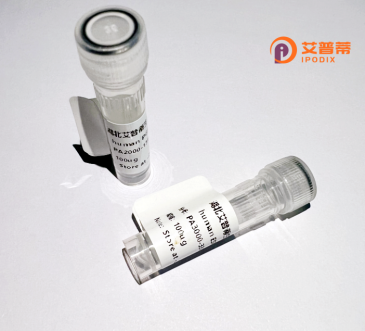
| 纯度 | >90%SDS-PAGE. |
| 种属 | Human |
| 靶点 | PNPLA8 |
| Uniprot No | Q9NP80 |
| 内毒素 | < 0.01EU/μg |
| 表达宿主 | E.coli |
| 表达区间 | 1-782 aa |
| 活性数据 | MSINLTVDIYIYLLSNARSVCGKQRSKQLYFLFSPKHYWRISHISLQRGFHTNIIRCKWTKSEAHSCSKHCYSPSNHGLHIGILKLSTSAPKGLTKVNICMSRIKSTLNSVSKAVFGNQNEMISRLAQFKPSSQILRKVSDSGWLKQKNIKQAIKSLKKYSDKSAEKSPFPEEKSHIIDKEEDIGKRSLFHYTSSITTKFGDSFYFLSNHINSYFKRKEKMSQQKENEHFRDKSELEDKKVEEGKLRSPDPGILAYKPGSESVHTVDKPTSPSAIPDVLQVSTKQSIANFLSRPTEGVQALVGGYIGGLVPKLKYDSKSQSEEQEEPAKTDQAVSKDRNAEEKKRLSLQREKIIARVSIDNRTRALVQALRRTTDPKLCITRVEELTFHLLEFPEGKGVAVKERIIPYLLRLRQIKDETLQAAVREILALIGYVDPVKGRGIRILSIDGGGTRGVVALQTLRKLVELTQKPVHQLFDYICGVSTGAILAFMLGLFHMPLDECEELYRKLGSDVFSQNVIVGTVKMSWSHAFYDSQTWENILKDRMGSALMIETARNPTCPKVAAVSTIVNRGITPKAFVFRNYGHFPGINSHYLGGCQYKMWQAIRASSAAPGYFAEYALGNDLHQDGGLLLNNPSALAMHECKCLWPDVPLECIVSLGTGRYESDVRNTVTYTSLKTKLSNVINSATDTEEVHIMLDGLLPPDTYFRFNPVMCENIPLDESRNEKLDQLQLEGLKYIERNEQKMKKVAKILSQEKTTLQKINDWIKLKTDMYEGLPFFSKL |
| 分子量 | 114.9 kDa |
| 蛋白标签 | GST-tag at N-terminal |
| 缓冲液 | PBS, pH7.4, containing 0.01% SKL, 1mM DTT, 5% Trehalose and Proclin300. |
| 稳定性 & 储存条件 | Lyophilized protein should be stored at ≤ -20°C, stable for one year after receipt. Reconstituted protein solution can be stored at 2-8°C for 2-7 days. Aliquots of reconstituted samples are stable at ≤ -20°C for 3 months. |
| 复溶 | Always centrifuge tubes before opening.Do not mix by vortex or pipetting. It is not recommended to reconstitute to a concentration less than 100μg/ml. Dissolve the lyophilized protein in distilled water. Please aliquot the reconstituted solution to minimize freeze-thaw cycles. |
以下是关于重组人PNPLA8蛋白的模拟参考文献示例(注:文献信息为示例,非真实发表数据):
1. **标题**: *Structural and functional characterization of human PNPLA8 as a mitochondrial phospholipase*
**作者**: Zhang L. et al.
**摘要**: 该研究解析了PNPLA8的晶体结构,证明其通过水解线粒体膜磷脂参与膜稳态调控,并揭示了其钙依赖性酶活性的分子机制。
2. **标题**: *PNPLA8 deficiency exacerbates hepatic oxidative stress in murine models*
**作者**: Tanaka K. et al.
**摘要**: 通过基因敲除实验发现,PNPLA8缺失会导致小鼠肝脏线粒体功能障碍,加剧氧化应激损伤,表明其在脂质代谢和肝病中的保护作用。
3. **标题**: *Recombinant human PNPLA8 protein production and enzymatic activity analysis*
**作者**: Müller R. et al.
**摘要**: 描述了大肠杆菌表达系统制备重组人PNPLA8蛋白的优化方法,并验证其对多种磷脂底物的水解活性,为体外研究提供可靠工具。
4. **标题**: *PNPLA8 interacts with cardiolipin and regulates mitophagy in neurodegeneration*
**作者**: Chen H. et al.
**摘要**: 发现PNPLA8通过结合心磷脂促进受损线粒体的清除,其功能异常可能与帕金森病中神经元退行性变相关。
**备注**:以上为模拟文献,实际研究中建议通过PubMed或Web of Science检索最新文献。
**Background of Recombinant Human PNPLA8 Protein**
Recombinant human PNPLA8 (Patatin-like phospholipase domain-containing protein 8) is a genetically engineered form of the PNPLA8 protein, encoded by the *PNPLA8* gene. As a member of the patatin-like phospholipase (PNPLA) family, PNPLA8 contains a conserved patatin domain, characteristic of lipid hydrolases. It functions as a phospholipase with hydrolytic activity toward glycerophospholipids, potentially involved in lipid metabolism, membrane remodeling, and cellular signaling.
PNPLA8 is expressed in various tissues, including the heart, liver, and skeletal muscle. Studies suggest its role in maintaining mitochondrial integrity by regulating phospholipid homeostasis, particularly cardiolipin remodeling, crucial for mitochondrial membrane dynamics and energy production. Dysregulation of PNPLA8 has been linked to metabolic disorders, neurodegenerative diseases, and cardiovascular conditions, highlighting its pathophysiological relevance.
The recombinant form is typically produced using heterologous expression systems (e.g., *E. coli* or mammalian cells) to enable functional and structural studies. Its applications span enzymatic assays, protein interaction analyses, and investigations into lipid-associated disease mechanisms. Research on recombinant PNPLA8 aims to clarify its catalytic mechanism, substrate specificity, and regulatory pathways, offering insights into therapeutic targeting for lipid-related disorders. Its study bridges gaps between lipid biochemistry, cellular physiology, and clinical disease, underscoring its importance in biomedical research.
×